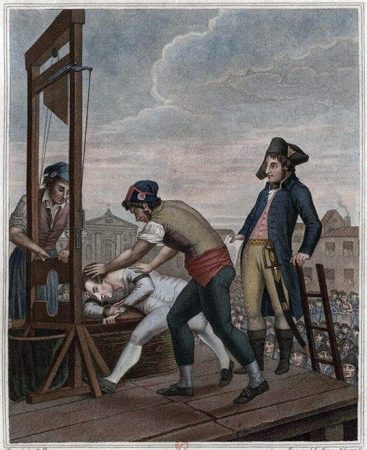
Jacques-Joseph Cassanyes (1758-1843) was a French politician and, later, a chronicler of the French Revolution. Born in Roussillon, close to the Spanish border, Cassanyes entered a seminary to train for the priesthood but later abandoned his in favour of medicine. In 1790 he became mayor of Canet and two years later was elected to the National Convention.
Republican by nature, Cassanyes voted for the abolition of the monarchy and the execution of Louis XVI and served with the army in his native south. Cassanyes was opposed to Maximilien Robespierre and participated in his overthrow in July 1794.
This account of Robespierre’s grisly execution comes from Cassanyes’ memoirs:
“On 10 Thermidor, at four in the afternoon, the sinister procession moved out of the courtyard of the Palais de Justice. No crowd of such a size had ever been seen in Paris. The streets were choked with people. Spectators, men and women of all ages, filled every window, and men had climbed on to the rooftops. There was universal jubilation coupled with popular fury. The long-suppressed hatred against these criminals now exploded with doubled force. Everyone applauded wildly and seemed to be sorry they could not do more.
Most of the watchers fixed their gaze on the cart in which Robespierre, his brother, Caution and Henriot were riding. These miserable creatures were all mutilated and covered with blood. They looked like a band of brigands the gendarmes had surprised in the forest and were unable to arrest without inflicting serious wounds upon them.
It would be difficult to describe the appearance of Robespierre. His face was wrapped in a bandage of dirty, bloodstained linen; his features were horribly disfigured. A pale pallor made it even more repulsive. He kept his eyes downward and almost closed; whether that was from the pain of his wounds or an awareness of his misdeeds, one cannot say.
Just before arriving at the place of execution, Robespierre was shaken out of his lethargy by a woman who forced her way through the crowd and rushed up to the cart carrying this cannibal. She grasped the cart rail with one hand and threatened Robespierre with the other, saying “Monster spewed from Hell. The thought of your punishment intoxicates me with joy”. Robespierre opened his eyes and looked at her sadly as she said: “Go now, evildoer, go down into your grave carrying the curses of the wives and mothers of France!”
When the cart had reached the foot of the scaffold, the executioners carried the tyrant down and laid him out prone until it was his turn for execution. While his accomplices were being beheaded, Robespierre appeared not to be taking notice; he kept his eyes shut and did not open them until he himself was carried up the scaffold. Some said that when he saw the instrument of death, he heaved a sigh of pain, but before dying he had to endure bitter suffering. After having thrown down his coat, the executioner roughly tore away the bandage and splint which the surgeon had put on his wounds. This unhinged his lower jaw from the upper jaw and caused the blood to flow in torrents.
The wretched man’s head was now no more than an object of horror and repulsion. When at last it was severed from his body and the executioner held it by the hair to show to the people, it presented an indescribably horrible sight. Thus perished the fiercest of the savage beasts, the most monstrous criminal that nature ever conceived. On the two days that followed, 83 other rebels were put to death, mainly members of the Commune or their outlawed accomplices.”
